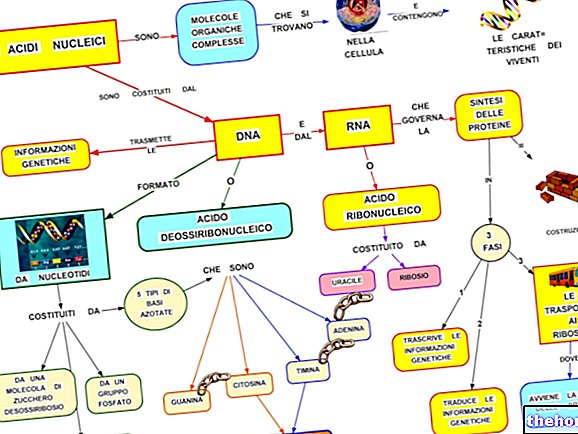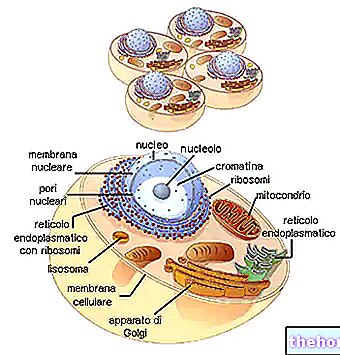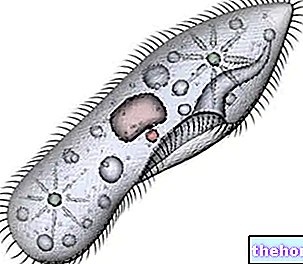Generality
Protozoa are unicellular microorganisms of the eukaryotic type, very widespread in nature.
In fact, the more than 50,000 different species of existing protozoa populate the most diverse habitats of the planet: from the soil to the deepest seas.

The protozoa live in close contact with the human being, but only on some occasions are they dangerous for the health of the latter.
Protozoa are responsible for some "famous" human infectious diseases, such as: malaria, toxoplasmosis, giardiasis, Chagas disease, etc.
What are protozoa?
Protozoa are a heterogeneous group of single-celled eukaryotic microorganisms, found in nearly all possible habitat types, from soil and the deepest sea to freshwater basins.
They are heterotrophic, ie organisms that derive energy and other compounds by feeding on organic substances processed by other organisms.
According to microbiologists, there are more than 50,000 different species of protozoa in nature.
Meaning of eukaryotic microorganism and unicellular microorganism
According to biologists, eukaryotes are all those microorganisms and organisms whose cellular DNA is enclosed within a structure known as the cell nucleus.
The fact of possessing a cell nucleus within which the genetic material resides is what distinguishes eukaryotes from so-called prokaryotes: in the latter the DNA is dispersed in the cytoplasm.
A single-celled microorganism is a microorganism consisting of only one cell.
It differs from a multicellular organism, which is instead a living being made up of several cells.
THEY ARE PROTISTS
Protozoa represent a sub-kingdom of the protist kingdom.
Protists are a group of microorganisms and organisms of the eukaryotic type, difficult to classify, as they have characteristics common to animals, plants and, in some cases, even fungi.
According to the definitions provided by the microbiology texts, all those eukaryotic living beings that cannot be inserted in the animal, vegetable or fungal kingdom fall into the kingdom of protists.
Classification
The classification of protozoa has always raised considerable debates.
Without going into too much detail of the most discussed points, here it was thought to report the most common distinction of protozoa, which discerns the aforementioned microorganisms on the basis of the structures for movement:
- Group of ciliated protozoa.Ciliated protozoa have this denomination because they have, all around the cell that constitutes them, small mobile hairs, known as cilia.
The synchronized movement of the cilia is what guarantees this group of protozoa to move.
The most important examples of ciliary protozoa are: - Balantidium coli
- Paramecium
- Group of flagellated protozoa. Flagellated protozoa have this identifying name, because the cell that constitutes them uses one or more flagella to move. Flagella are elongated mobile structures, similar to long mobile cilia.
The most important examples of flagellated protozoa are: - Giardia lamblia
- Trypanosoma brucei
- Trypanosoma cruzi
- Trichomonas vaginalis
- Group of the sporozoa protozoa. Sporozoa protozoa lack structures responsible for movement (flagellum or cilia).
They have the particularity of behaving like parasites towards those living beings (animals or humans), with which they manage to come into contact.
Sporozoa protozoa can pose a real threat to the good health of parasitic subjects.
The most important examples of protozoan sporozoa are: - Plasmodium knowlesi
- Plasmodium malariae (the famous causative agent of malaria in humans)
- Toxoplasma gondii (the famous causative agent of toxoplasmosis in humans)
- Group of amoeboid protozoa. Amoeboid protozoa move by everting the plasma membrane, ejections that microbiologists refer to as pseudopodia.
The ability to create these protrusions also allows these microorganisms to incorporate potentially nutritious substances, which they find in the environment.
The most important examples of amoeboid protozoa are: - Entamoeba histolytica
- Acanthamoeba
History
The first person to notice the existence of protozoa was a Dutch scientist named Anton Van Leeuwenhoek, who lived between 1632 and 1723.
Van Leeuwenhoek's studies on protozoa began in 1674 and ended in 1716: in this period the Dutch scientist discovered a rather famous protozoan, which in the future took the name of Giardia lamblia.
The German zoologist Georg August Goldfuss coined the term "protozoa" (singular "protozoan") in 1818.
Literally, the word "protozoa" means "primitive organisms".
Features
Typically, protozoa are between 10 and 50 micrometers in size.
There are, however, particular protozoa which, from the point of view of size, represent real exceptions and can even reach 20 centimeters in diameter (N.B: it is a protozoan that lives in the depths of the sea, known as Xenophyophorea).
FILM
Some protozoa - notably ciliated protozoa - have an outer skin, which supports the entire plasma membrane (thus enveloping the entire protozoan cell).
The functions of the film are mainly two:
- Further protect the cell e
- Maintain the shape of the cell while on the move.
The protozoan film can be flexible and elastic, or rigid.
POWER MODE
Protozoa can take food in several ways:
- By osmosis. It means there is a passage of nutrients through the cell membrane.
- By phagocytosis. It means that the absorption of food occurs through extroflexions of the plasma membrane (the pseudopodia already mentioned).
- Through cytostome. The cytostome is a "mouth-like opening."
LIFE CYCLE
The life cycle of protozoa includes two stages:
- A stage of intense activity and mobility, during which protozoa are also called trophozoites.
Trophozoites are, in fact, protozoa in the active life form. - A dormancy stage, during which protozoa are also called protozoan cysts.
Protozoa enter this stage when they are faced with periods of time in which they do not have available nutrients, water or oxygen, or in which environmental conditions are inhospitable (high temperatures, exposure to toxic chemicals, etc.).
PLAYBACK
Typically, protozoa reproduce by binary fission (or binary fission).
Binary fission is a form of asexual reproduction, very common among simple microorganisms such as single-celled ones.
RELATIONS WITH THE HUMAN BEING
Perhaps not everyone knows that there is a close relationship between humans and protozoa: the latter, in fact, populate our skin or live inside the gastrointestinal tract like many bacteria, without having particular repercussions on health.
The protozoa that live in close contact with humans can be dangerous when the human immune defenses lose their effectiveness.
Diseases in humans
The protozoa that can cause disease in humans have all the connotations of parasites and take the generic name of pathogenic protozoa.
The main pathogenic protozoa cause:
- Malaria. It is a very common infectious disease in tropical areas, which can cause fever, chills, sweating, irritability, fatigue, decreased appetite, etc.
It causes: Plasmodium malariae, belonging to the group of sporozoa protozoa. - Amoebiasis. It is a fecal-oral infection that usually causes intestinal symptoms.
It causes: Entamoeba histolytica, belonging to the group of amoeboid protozoa. - Amoebic dysentery. It is an infectious disease with several similarities to amoebiasis. It is responsible for diarrhea, abdominal pain and fever.
It causes: Entamoeba histolytica, belonging to the group of amoeboid protozoa. - Giardiasis. It is a "parasitic infection that produces gastrointestinal symptoms (diarrhea, nausea, vomiting, etc.).
It causes: Giardia lamblia, belonging to the group of flagellated protozoa. - Toxoplasmosis. It is a generally asymptomatic infection. When symptomatic, it is responsible for flu-like symptoms. Very dangerous if contracted during pregnancy, as it can cause mental retardation in the fetus or miscarriage.
It causes: Toxoplasmosis gondii, belonging to the group of sporozoa protozoa. - Cryptosporidiosis. It is an "infection that affects the gut" and mainly causes diarrhea.
It causes: Cryptosporidium, belonging to the group of sporozoa protozoa. - Trichomoniasis. It is a sexually transmitted infectious disease that attacks the vagina (in women), urethra and prostate (in men).
It causes: Trichomonas vaginalis, belonging to the group of flagellated protozoa. - Chagas's disease. It is an infectious disease that begins with fever, swollen lymph nodes and headache and culminates in cardiomyopathy and heart failure at the end of its course.
It causes: Trypanosoma cruzi, belonging to the group of flagellated protozoa. - Human leishmaniasis. Widespread mainly in tropical and subtropical areas, it can affect the skin (cutaneous leishmaniasis) or some internal organs, including the spleen, liver or bone marrow (visceral leishmaniasis).
It causes: Leishmania, belonging to the group of flagellated protozoa. - African trypanosomiasis. Better known as sleeping sickness, it is an infectious disease that can cause: joint pain, fever, swollen lymph nodes in the neck, itching, anemia (at an advanced stage), heart dysfunction (at an advanced stage) and kidney dysfunction (at an advanced stage). advanced stage).
It causes: Trypanosoma, belonging to the group of flagellated protozoa. - Keratitis from Acanthamoeba. It is an infectious eye disease, which mainly affects contact lens wearers.
It causes: Acanthamoeba, belonging to the group of amoeboid protozoa. - Primary amoebic meningoencephalitis. It is an infectious disease responsible for an inflammatory state that damages the meninges and the brain.
Typical symptoms consist of: headache, fever, blindness, hallucinations and / or euphoria.
It causes: Acanthamoeba, belonging to the group of amoeboid protozoa.




























